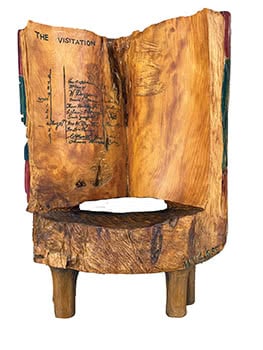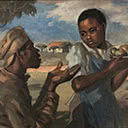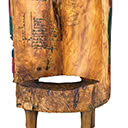The Visitation
67 x 50 cm
est. $3,000 - 4,000
PROVENANCE
Judith Anderson Collection
ILLUSTRATED
p. 48 & 49 Warren Viscoe Life and Limb Justin Paton, Sarjeant Gallery, 2000
Open the Auckland Art Gallery visitors' book for August 26, 1895, and there is the famous signature. Unwashed, tired, strapped for cash, the post- impressionist painter Paul Gauguin spent ten days in Auckland in August 1895, on his way to Tahiti for the second and last time. Gauguin had fled France for what he hoped would be a South Seas Eden, and in the Auckland Art Gallery and the Auckland Museum he made shorthand sketches of Maori carvings. Transported into paintings, they became emblems of the strange new beauty that Gauguin dreamed of finding in the Pacific.
One hundred years later, Warren Viscoe has returned to the traces of Gauguin's visitation and enshrined them in art. Carving into a big butcher's block of kauri with a no-nonsense confidence that Gauguin might have admired, Viscoe has fashioned his own version of the Auckland Art Gallery visitors' book. The kauri has a vital glow, and Gauguin's signature is chiselled into the body of this indigenous wood as though it were a tattoo.
We are a long way from Viscoe's art-as-evidence experiments of the '70s, but he is still reconstructing the traces of human habitation, still reading the grain of past events. Viscoe is fascinated not by the big bland abstractions that are passed down to us as history but by the marks and evidence that accumulate in history's margins. This fascination is what led him, two years after making The Visitation for an exhibition commemorating Gauguin's trip, to pick up the chisel again and surround Gauguin's name with the names of those forgotten travellers - Thomas Hartley of Hokianga, Mr and Mrs Morris of New Plymouth - who preceded and followed him into the museum.
The sculpture resembles both a stool and a traditional Polynesian headrest, so Viscoe seems to be offering weary travellers - past or present - a place to rest or sleep en route. Gauguin died in Tahiti in 1903.
Text Warren Viscoe Life & Limb published by Sarjeant Gallery, 2000





